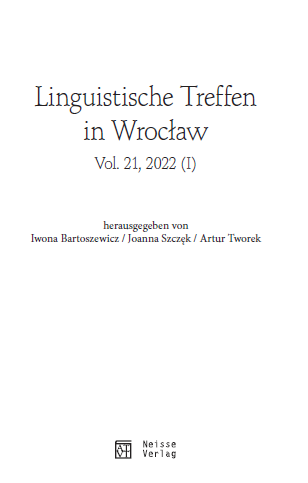Der adnominale possessive Dativ im Dialekt von Deutschpilsen (ungarisch Nagybörzsöny)
The Adnominal Possessive Dative in the Dialect of Deutschpilsen (Nagybörzsöny)
Author(s): Éva MárkusSubject(s): Gender Studies, Theoretical Linguistics, Sociolinguistics
Published by: Oficyna Wydawnicza ATUT – Wrocławskie Wydawnictwo Oświatowe
Keywords: dativ+possessive-construction; dialect; language island; gender incongruence;
Summary/Abstract: The article deals with the adnominal dative+possessive construction of the type in Bęəbən ir Gətrax (‘the women their costume = the costume of women’) and its different variants in the German dialect of Deutschpilsen, a small Hungarian language island in northern Hungary. It is a medieval settlement, in the past its inhabitants were mainly engaged in mining and probably came from the south and the middle east of the German-speaking area. A mixed dialect was created. The basic dialect of the remote village has preserved many archaic elements to this day. The dialect is currently threatened with extinction, it has become a language of elderly people and memory. The adnominal dative+possessive construction has a wide range of literature, and the article would like to present new findings in addition. The analysis is carried out on empirically collected linguistic data that was recorded with the help of a questionnaire in Deutschpilsen. The informants were elderly villagers who still speak the dialect as their mother tongue. Particular attention is paid to the subject of gender and pronominal reference in the dative+possessive construction. The conflict between grammatical and referential gender is shown, as in the example in Hoz iər Gartn (‘the house her garden = the garden of the house’). For this grammatical discrepancy (neutral article, feminine pronominalization), justifications are sought in literature. The gender congruence between antecedent and possessive is often cancelled in the examined dialect, incongruences between the article and pronoun can arise. Incongruent forms with reference to a masculine or neuter can be observed. The variants with masculine/neutral articles and feminine possessive pronouns are particularly striking: ən Knab iər Štim (‘a boy her voice = the voice of a boy’). I have not found any similar evidence in the dialectological literature. The article documents and describes three types of adnominal dative+possessive construction, illustrated with plenty of example sentences from Deutschpilsen. The relationship between genitive and possessive dative, which is much discussed in the literature, is also shed in a new light.
Journal: Linguistische Treffen in Wrocław
- Issue Year: 21/2022
- Issue No: 1
- Page Range: 129-142
- Page Count: 14
- Language: German

